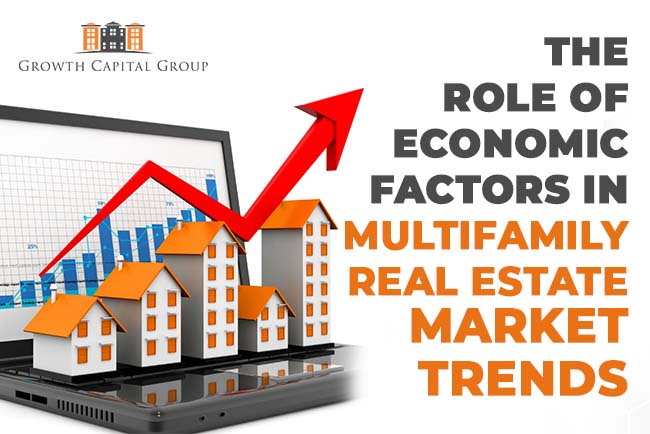The multifamily real estate market trends are influenced by various factors, with economic indicators playing a significant role in shaping its trends. Economic factors provide crucial insights into the overall health of the economy and affect the demand and supply dynamics within the multifamily real estate sector. In this article, we will explore the key economic factors that impact multifamily real estate market trends and understand their implications for investors, developers, and renters alike.
Understanding Economic Factors in Multifamily Real Estate Market Trends
- Gross Domestic Product (GDP)
The value of all products and services generated inside a nation’s borders is measured by its GDP, a crucial economic statistic. A growing GDP indicates a robust economy with higher consumer spending power, which can positively impact the multifamily real estate market. When GDP is on the rise, individuals and families have higher incomes, increasing the demand for rental properties. - Employment and Wage Growth
Employment and wage growth are closely linked to the multifamily real estate market. When the job market is thriving and wages are increasing, more people can afford to rent or upgrade their living arrangements. Conversely, a stagnant job market or declining wages may lead to decreased demand for multifamily properties. - Interest Rates
Interest rates have a significant influence on the cost of borrowing and can affect both developers and renters. Lower interest rates encourage developers to invest in new multifamily projects, resulting in increased supply. Additionally, lower rates can make homeownership less attractive, leading to higher demand for rental properties.
Population Dynamics
1 Demographic Changes
Demographic shifts, such as changes in age distribution and household formation patterns, impact multifamily real estate market trends. For instance, the millennial generation’s preferences for urban living and delayed homeownership have fueled the demand for multifamily properties in city centres.
2 Migration Patterns
Migration patterns play a role in determining the demand for multifamily properties in specific regions. Factors such as job opportunities, lifestyle preferences, and affordability can influence individuals and families to move to certain areas, thereby affecting the multifamily real estate market.
Supply and Demand Dynamics
1 Housing Inventory
The availability of housing inventory directly affects the multifamily real estate market. When there is a shortage of rental units, landlords have more leverage, leading to higher rental rates. Conversely, an oversupply of rental properties can result in increased competition among landlords and potentially lower rental rates.
2 Rental Affordability
Affordability is a crucial factor in the multifamily real estate market. Rising rental costs relative to incomes can make renting less affordable for individuals and families, potentially leading to a decrease in demand. On the other hand, affordable rental options can attract more tenants and drive market growth.
Market Sentiment and Investor Confidence
1 Consumer Confidence
Consumer confidence reflects people’s optimism about the overall state of the economy. High consumer confidence often translates into increased spending and a stronger housing market, including the multifamily sector. Positive sentiment can drive demand for rental properties and stimulate investment activity.
2 Investor Sentiment
Investor sentiment plays a vital role in shaping multifamily real estate market trends. Favourable economic conditions and market stability can boost investor confidence, attracting capital to the sector. On the contrary, economic uncertainty may lead to cautious investor behaviour, impacting market dynamics.
Government Policies and Regulations
1 Tax Incentives
Government policies, such as tax incentives for real estate development or rental properties, can influence the multifamily market. Tax benefits can incentivize developers to invest in multifamily projects, potentially increasing the supply of rental units and impacting market trends.
2 Zoning and Land Use Regulations
Zoning and land use regulations imposed by local governments can affect the availability and development of multifamily properties. Restrictive regulations may limit new construction or restrict the conversion of existing properties, leading to supply constraints and potential market imbalances.
Read more about Multifamily Investment Strategy for Cash Flow Generation
Conclusion
Economic factors play a crucial role in shaping multifamily real estate market trends. GDP growth, employment and wage dynamics, interest rates, population changes, supply and demand dynamics, market sentiment, and government policies all influence the multifamily market. Understanding these factors is essential for investors, developers, and renters to make informed decisions in this ever-evolving sector.
Related The Multifamily Real Estate Landscape
Feel free to contact us with any questions regarding multifamily investment.
FAQs (Frequently Asked Questions)
Q: How do economic factors impact multifamily real estate investment?
Economic factors such as GDP growth and employment rates can influence the demand for rental properties and affect the profitability of multifamily real estate investments.
Q: What role does population growth play in the multifamily real estate market?
Population growth, especially in urban areas, drives the demand for multifamily properties as individuals and families seek housing options in vibrant and convenient locations.
Q: How do interest rates affect multifamily real estate financing?
Lower interest rates can make borrowing more affordable, encouraging developers to invest in multifamily projects and potentially increasing the supply of rental units.
Q: What impact do government policies have on the multifamily real estate market?
Government policies, such as tax incentives and zoning regulations, can influence the availability of rental properties and impact market trends.
Q: Why is consumer confidence important for the multifamily real estate market?
High consumer confidence indicates a strong economy and can drive demand for rental properties, contributing to market growth.

